Environmental Health Risk Assessment
VerifiedAdded on 2023/01/18
|13
|3613
|25
AI Summary
This essay discusses the process of environmental health risk assessment and its significance in public health protection. It focuses on the hazards and risks associated with poorly constructed inner-city apartments and overcrowding in Melbourne. The essay also explores the importance of risk management plans in mitigating these risks.
Contribute Materials
Your contribution can guide someone’s learning journey. Share your
documents today.
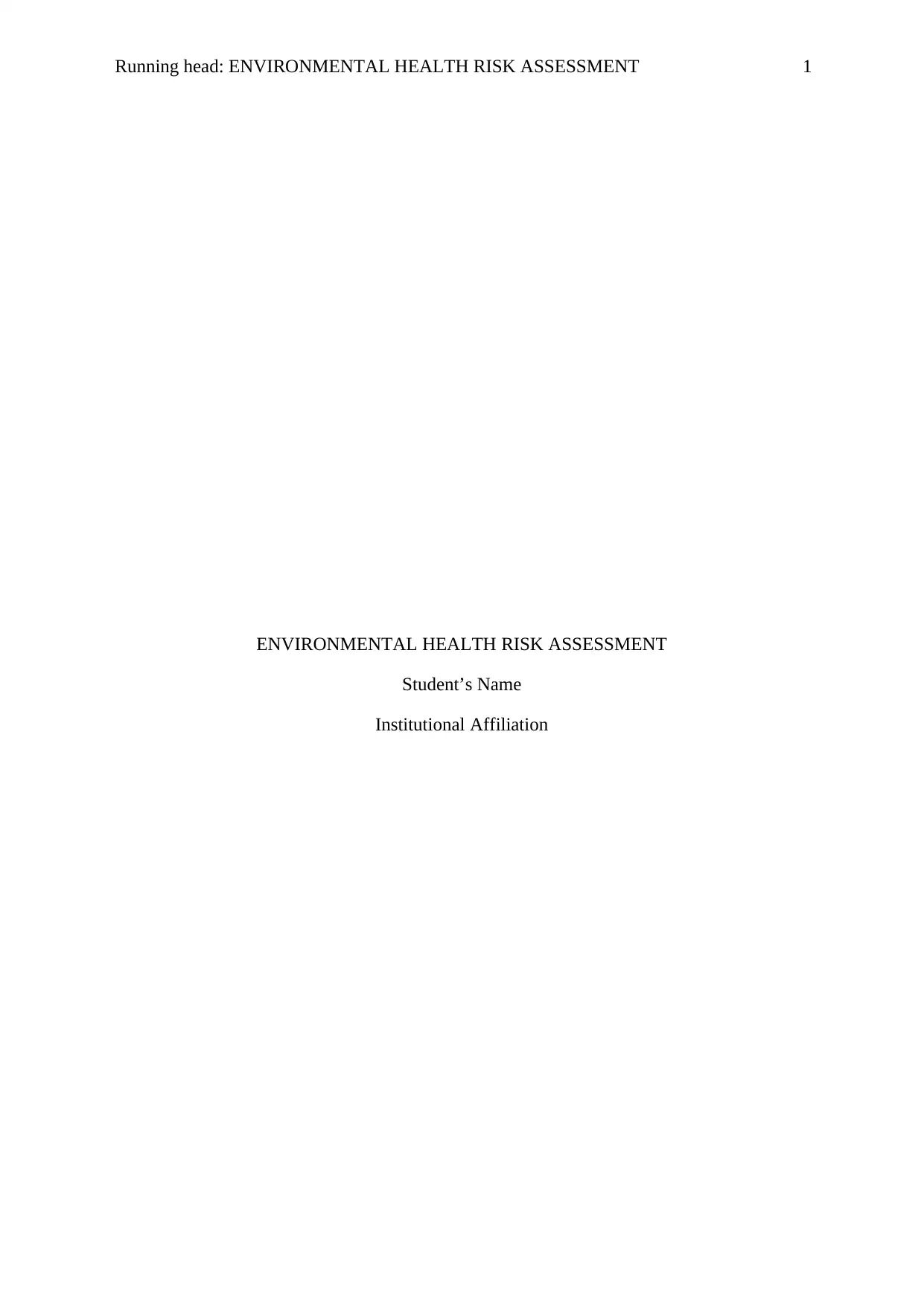
Running head: ENVIRONMENTAL HEALTH RISK ASSESSMENT 1
ENVIRONMENTAL HEALTH RISK ASSESSMENT
Student’s Name
Institutional Affiliation
ENVIRONMENTAL HEALTH RISK ASSESSMENT
Student’s Name
Institutional Affiliation
Secure Best Marks with AI Grader
Need help grading? Try our AI Grader for instant feedback on your assignments.
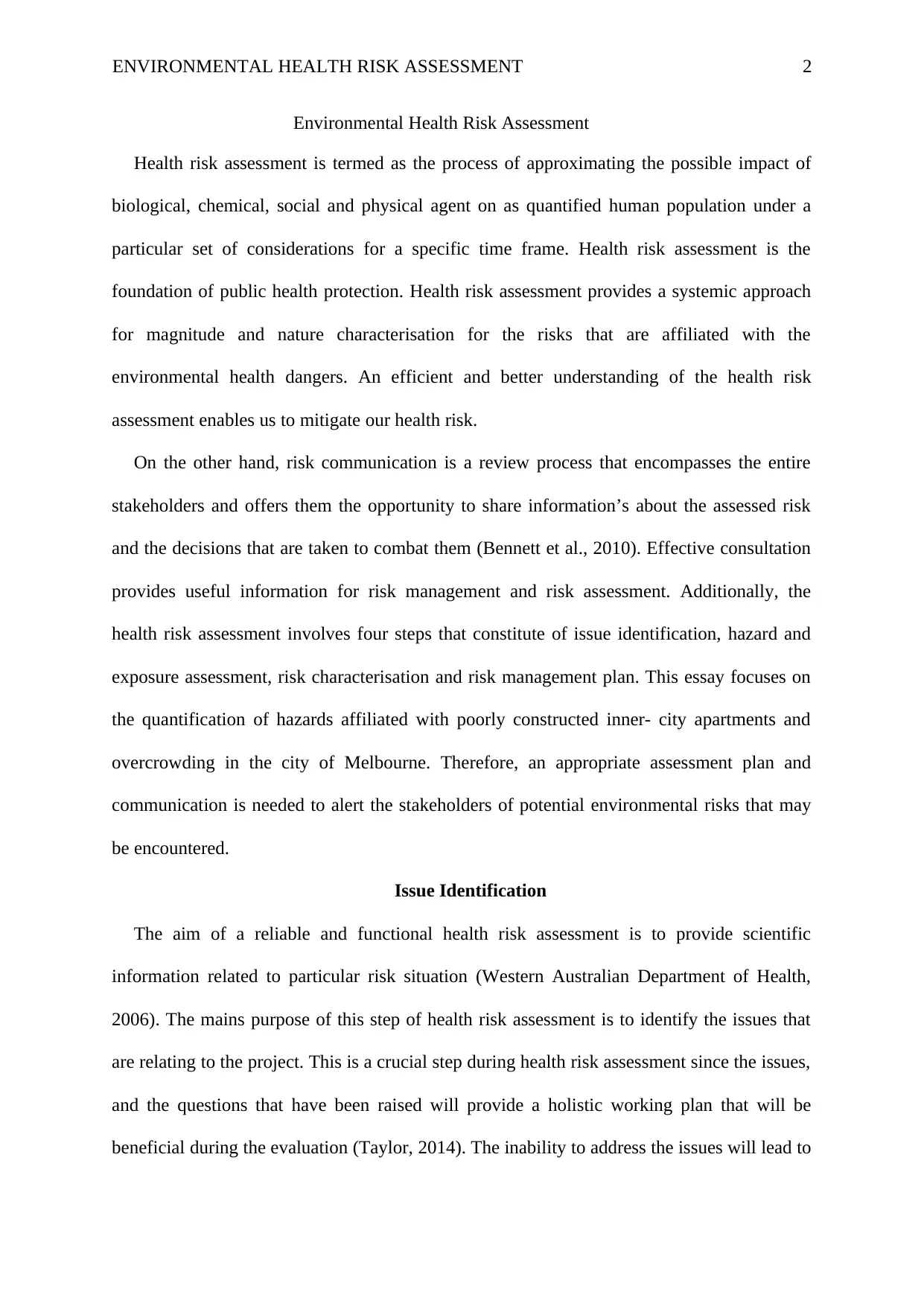
ENVIRONMENTAL HEALTH RISK ASSESSMENT 2
Environmental Health Risk Assessment
Health risk assessment is termed as the process of approximating the possible impact of
biological, chemical, social and physical agent on as quantified human population under a
particular set of considerations for a specific time frame. Health risk assessment is the
foundation of public health protection. Health risk assessment provides a systemic approach
for magnitude and nature characterisation for the risks that are affiliated with the
environmental health dangers. An efficient and better understanding of the health risk
assessment enables us to mitigate our health risk.
On the other hand, risk communication is a review process that encompasses the entire
stakeholders and offers them the opportunity to share information’s about the assessed risk
and the decisions that are taken to combat them (Bennett et al., 2010). Effective consultation
provides useful information for risk management and risk assessment. Additionally, the
health risk assessment involves four steps that constitute of issue identification, hazard and
exposure assessment, risk characterisation and risk management plan. This essay focuses on
the quantification of hazards affiliated with poorly constructed inner- city apartments and
overcrowding in the city of Melbourne. Therefore, an appropriate assessment plan and
communication is needed to alert the stakeholders of potential environmental risks that may
be encountered.
Issue Identification
The aim of a reliable and functional health risk assessment is to provide scientific
information related to particular risk situation (Western Australian Department of Health,
2006). The mains purpose of this step of health risk assessment is to identify the issues that
are relating to the project. This is a crucial step during health risk assessment since the issues,
and the questions that have been raised will provide a holistic working plan that will be
beneficial during the evaluation (Taylor, 2014). The inability to address the issues will lead to
Environmental Health Risk Assessment
Health risk assessment is termed as the process of approximating the possible impact of
biological, chemical, social and physical agent on as quantified human population under a
particular set of considerations for a specific time frame. Health risk assessment is the
foundation of public health protection. Health risk assessment provides a systemic approach
for magnitude and nature characterisation for the risks that are affiliated with the
environmental health dangers. An efficient and better understanding of the health risk
assessment enables us to mitigate our health risk.
On the other hand, risk communication is a review process that encompasses the entire
stakeholders and offers them the opportunity to share information’s about the assessed risk
and the decisions that are taken to combat them (Bennett et al., 2010). Effective consultation
provides useful information for risk management and risk assessment. Additionally, the
health risk assessment involves four steps that constitute of issue identification, hazard and
exposure assessment, risk characterisation and risk management plan. This essay focuses on
the quantification of hazards affiliated with poorly constructed inner- city apartments and
overcrowding in the city of Melbourne. Therefore, an appropriate assessment plan and
communication is needed to alert the stakeholders of potential environmental risks that may
be encountered.
Issue Identification
The aim of a reliable and functional health risk assessment is to provide scientific
information related to particular risk situation (Western Australian Department of Health,
2006). The mains purpose of this step of health risk assessment is to identify the issues that
are relating to the project. This is a crucial step during health risk assessment since the issues,
and the questions that have been raised will provide a holistic working plan that will be
beneficial during the evaluation (Taylor, 2014). The inability to address the issues will lead to
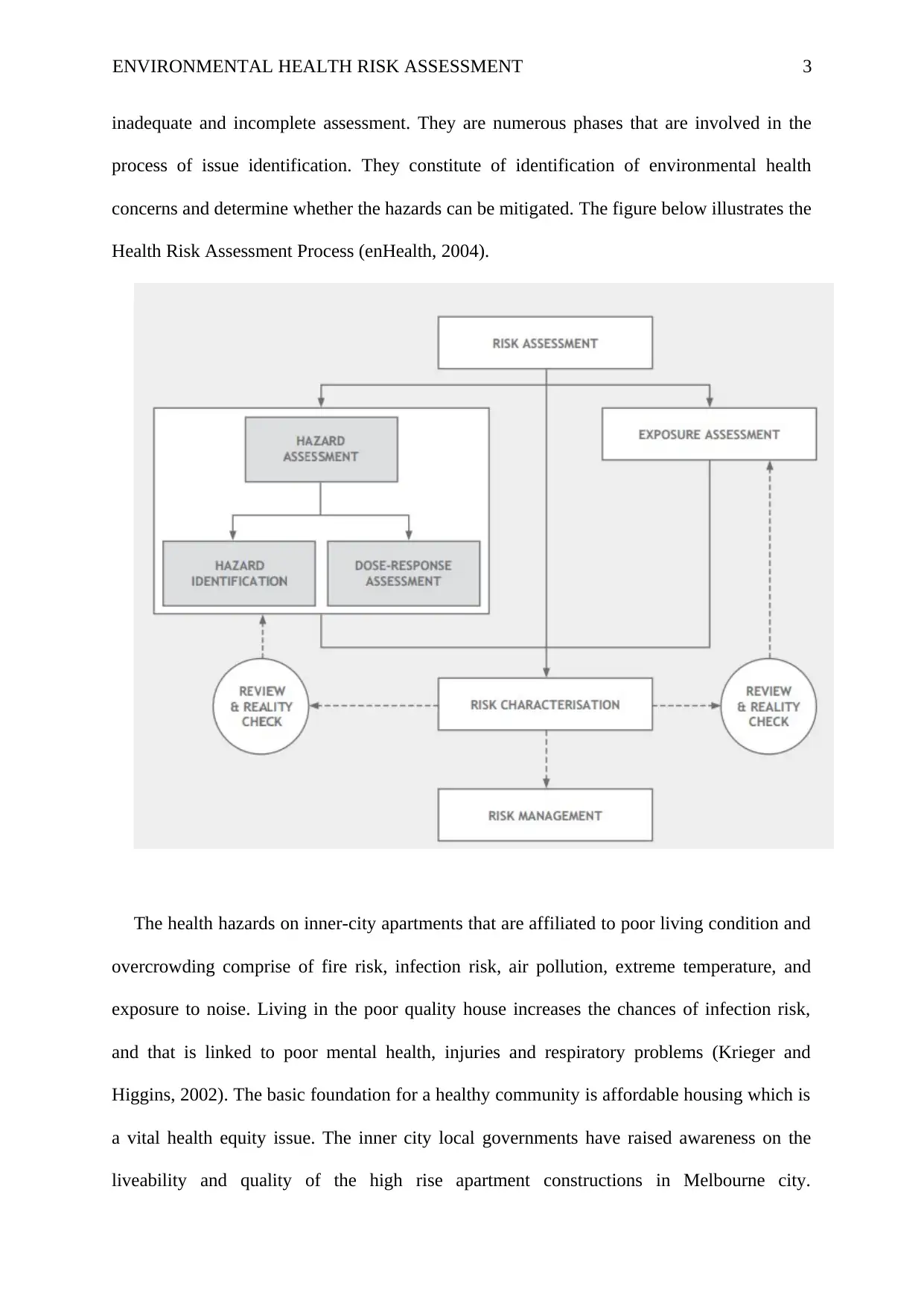
ENVIRONMENTAL HEALTH RISK ASSESSMENT 3
inadequate and incomplete assessment. They are numerous phases that are involved in the
process of issue identification. They constitute of identification of environmental health
concerns and determine whether the hazards can be mitigated. The figure below illustrates the
Health Risk Assessment Process (enHealth, 2004).
The health hazards on inner-city apartments that are affiliated to poor living condition and
overcrowding comprise of fire risk, infection risk, air pollution, extreme temperature, and
exposure to noise. Living in the poor quality house increases the chances of infection risk,
and that is linked to poor mental health, injuries and respiratory problems (Krieger and
Higgins, 2002). The basic foundation for a healthy community is affordable housing which is
a vital health equity issue. The inner city local governments have raised awareness on the
liveability and quality of the high rise apartment constructions in Melbourne city.
inadequate and incomplete assessment. They are numerous phases that are involved in the
process of issue identification. They constitute of identification of environmental health
concerns and determine whether the hazards can be mitigated. The figure below illustrates the
Health Risk Assessment Process (enHealth, 2004).
The health hazards on inner-city apartments that are affiliated to poor living condition and
overcrowding comprise of fire risk, infection risk, air pollution, extreme temperature, and
exposure to noise. Living in the poor quality house increases the chances of infection risk,
and that is linked to poor mental health, injuries and respiratory problems (Krieger and
Higgins, 2002). The basic foundation for a healthy community is affordable housing which is
a vital health equity issue. The inner city local governments have raised awareness on the
liveability and quality of the high rise apartment constructions in Melbourne city.
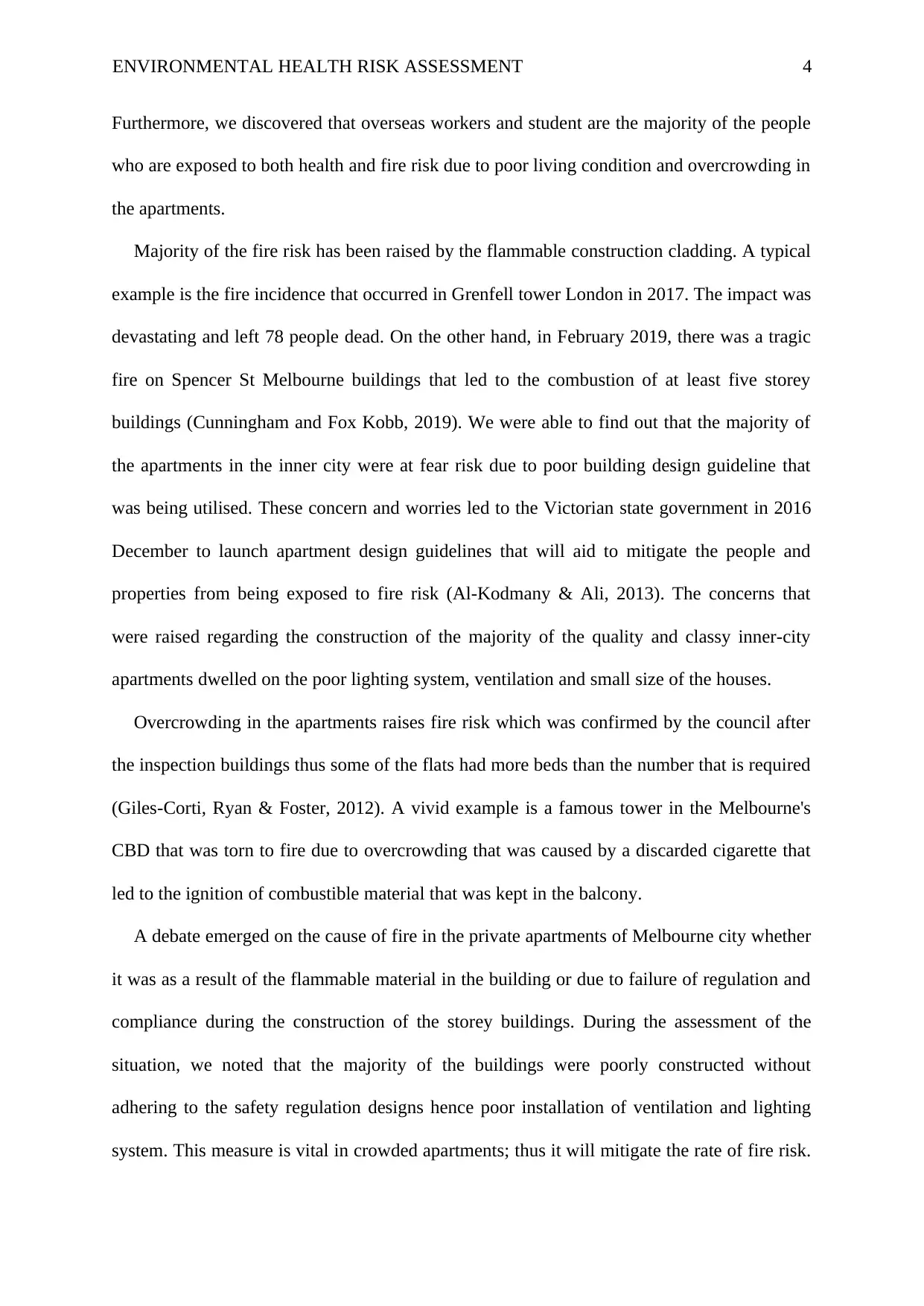
ENVIRONMENTAL HEALTH RISK ASSESSMENT 4
Furthermore, we discovered that overseas workers and student are the majority of the people
who are exposed to both health and fire risk due to poor living condition and overcrowding in
the apartments.
Majority of the fire risk has been raised by the flammable construction cladding. A typical
example is the fire incidence that occurred in Grenfell tower London in 2017. The impact was
devastating and left 78 people dead. On the other hand, in February 2019, there was a tragic
fire on Spencer St Melbourne buildings that led to the combustion of at least five storey
buildings (Cunningham and Fox Kobb, 2019). We were able to find out that the majority of
the apartments in the inner city were at fear risk due to poor building design guideline that
was being utilised. These concern and worries led to the Victorian state government in 2016
December to launch apartment design guidelines that will aid to mitigate the people and
properties from being exposed to fire risk (Al-Kodmany & Ali, 2013). The concerns that
were raised regarding the construction of the majority of the quality and classy inner-city
apartments dwelled on the poor lighting system, ventilation and small size of the houses.
Overcrowding in the apartments raises fire risk which was confirmed by the council after
the inspection buildings thus some of the flats had more beds than the number that is required
(Giles-Corti, Ryan & Foster, 2012). A vivid example is a famous tower in the Melbourne's
CBD that was torn to fire due to overcrowding that was caused by a discarded cigarette that
led to the ignition of combustible material that was kept in the balcony.
A debate emerged on the cause of fire in the private apartments of Melbourne city whether
it was as a result of the flammable material in the building or due to failure of regulation and
compliance during the construction of the storey buildings. During the assessment of the
situation, we noted that the majority of the buildings were poorly constructed without
adhering to the safety regulation designs hence poor installation of ventilation and lighting
system. This measure is vital in crowded apartments; thus it will mitigate the rate of fire risk.
Furthermore, we discovered that overseas workers and student are the majority of the people
who are exposed to both health and fire risk due to poor living condition and overcrowding in
the apartments.
Majority of the fire risk has been raised by the flammable construction cladding. A typical
example is the fire incidence that occurred in Grenfell tower London in 2017. The impact was
devastating and left 78 people dead. On the other hand, in February 2019, there was a tragic
fire on Spencer St Melbourne buildings that led to the combustion of at least five storey
buildings (Cunningham and Fox Kobb, 2019). We were able to find out that the majority of
the apartments in the inner city were at fear risk due to poor building design guideline that
was being utilised. These concern and worries led to the Victorian state government in 2016
December to launch apartment design guidelines that will aid to mitigate the people and
properties from being exposed to fire risk (Al-Kodmany & Ali, 2013). The concerns that
were raised regarding the construction of the majority of the quality and classy inner-city
apartments dwelled on the poor lighting system, ventilation and small size of the houses.
Overcrowding in the apartments raises fire risk which was confirmed by the council after
the inspection buildings thus some of the flats had more beds than the number that is required
(Giles-Corti, Ryan & Foster, 2012). A vivid example is a famous tower in the Melbourne's
CBD that was torn to fire due to overcrowding that was caused by a discarded cigarette that
led to the ignition of combustible material that was kept in the balcony.
A debate emerged on the cause of fire in the private apartments of Melbourne city whether
it was as a result of the flammable material in the building or due to failure of regulation and
compliance during the construction of the storey buildings. During the assessment of the
situation, we noted that the majority of the buildings were poorly constructed without
adhering to the safety regulation designs hence poor installation of ventilation and lighting
system. This measure is vital in crowded apartments; thus it will mitigate the rate of fire risk.
Secure Best Marks with AI Grader
Need help grading? Try our AI Grader for instant feedback on your assignments.
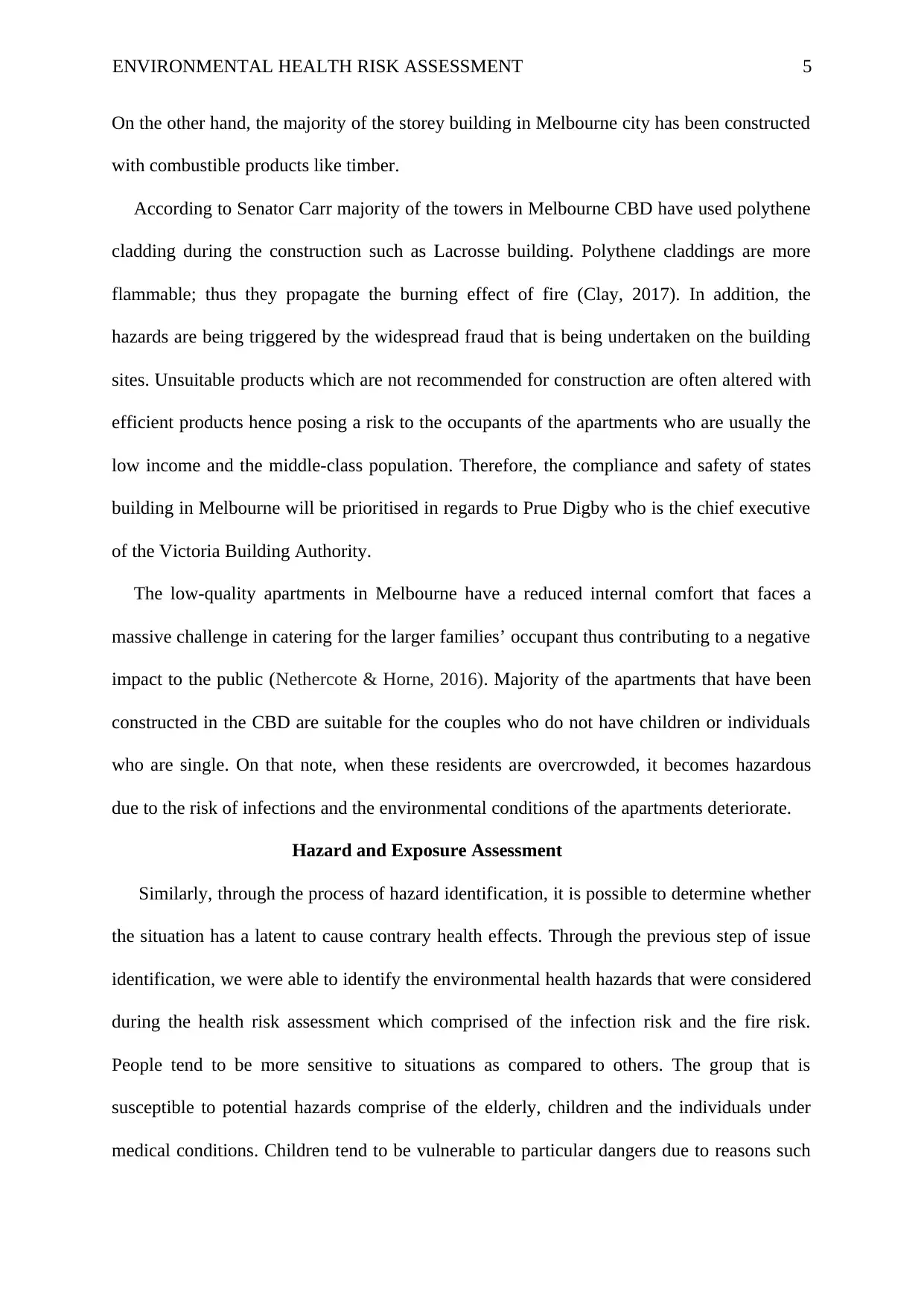
ENVIRONMENTAL HEALTH RISK ASSESSMENT 5
On the other hand, the majority of the storey building in Melbourne city has been constructed
with combustible products like timber.
According to Senator Carr majority of the towers in Melbourne CBD have used polythene
cladding during the construction such as Lacrosse building. Polythene claddings are more
flammable; thus they propagate the burning effect of fire (Clay, 2017). In addition, the
hazards are being triggered by the widespread fraud that is being undertaken on the building
sites. Unsuitable products which are not recommended for construction are often altered with
efficient products hence posing a risk to the occupants of the apartments who are usually the
low income and the middle-class population. Therefore, the compliance and safety of states
building in Melbourne will be prioritised in regards to Prue Digby who is the chief executive
of the Victoria Building Authority.
The low-quality apartments in Melbourne have a reduced internal comfort that faces a
massive challenge in catering for the larger families’ occupant thus contributing to a negative
impact to the public (Nethercote & Horne, 2016). Majority of the apartments that have been
constructed in the CBD are suitable for the couples who do not have children or individuals
who are single. On that note, when these residents are overcrowded, it becomes hazardous
due to the risk of infections and the environmental conditions of the apartments deteriorate.
Hazard and Exposure Assessment
Similarly, through the process of hazard identification, it is possible to determine whether
the situation has a latent to cause contrary health effects. Through the previous step of issue
identification, we were able to identify the environmental health hazards that were considered
during the health risk assessment which comprised of the infection risk and the fire risk.
People tend to be more sensitive to situations as compared to others. The group that is
susceptible to potential hazards comprise of the elderly, children and the individuals under
medical conditions. Children tend to be vulnerable to particular dangers due to reasons such
On the other hand, the majority of the storey building in Melbourne city has been constructed
with combustible products like timber.
According to Senator Carr majority of the towers in Melbourne CBD have used polythene
cladding during the construction such as Lacrosse building. Polythene claddings are more
flammable; thus they propagate the burning effect of fire (Clay, 2017). In addition, the
hazards are being triggered by the widespread fraud that is being undertaken on the building
sites. Unsuitable products which are not recommended for construction are often altered with
efficient products hence posing a risk to the occupants of the apartments who are usually the
low income and the middle-class population. Therefore, the compliance and safety of states
building in Melbourne will be prioritised in regards to Prue Digby who is the chief executive
of the Victoria Building Authority.
The low-quality apartments in Melbourne have a reduced internal comfort that faces a
massive challenge in catering for the larger families’ occupant thus contributing to a negative
impact to the public (Nethercote & Horne, 2016). Majority of the apartments that have been
constructed in the CBD are suitable for the couples who do not have children or individuals
who are single. On that note, when these residents are overcrowded, it becomes hazardous
due to the risk of infections and the environmental conditions of the apartments deteriorate.
Hazard and Exposure Assessment
Similarly, through the process of hazard identification, it is possible to determine whether
the situation has a latent to cause contrary health effects. Through the previous step of issue
identification, we were able to identify the environmental health hazards that were considered
during the health risk assessment which comprised of the infection risk and the fire risk.
People tend to be more sensitive to situations as compared to others. The group that is
susceptible to potential hazards comprise of the elderly, children and the individuals under
medical conditions. Children tend to be vulnerable to particular dangers due to reasons such
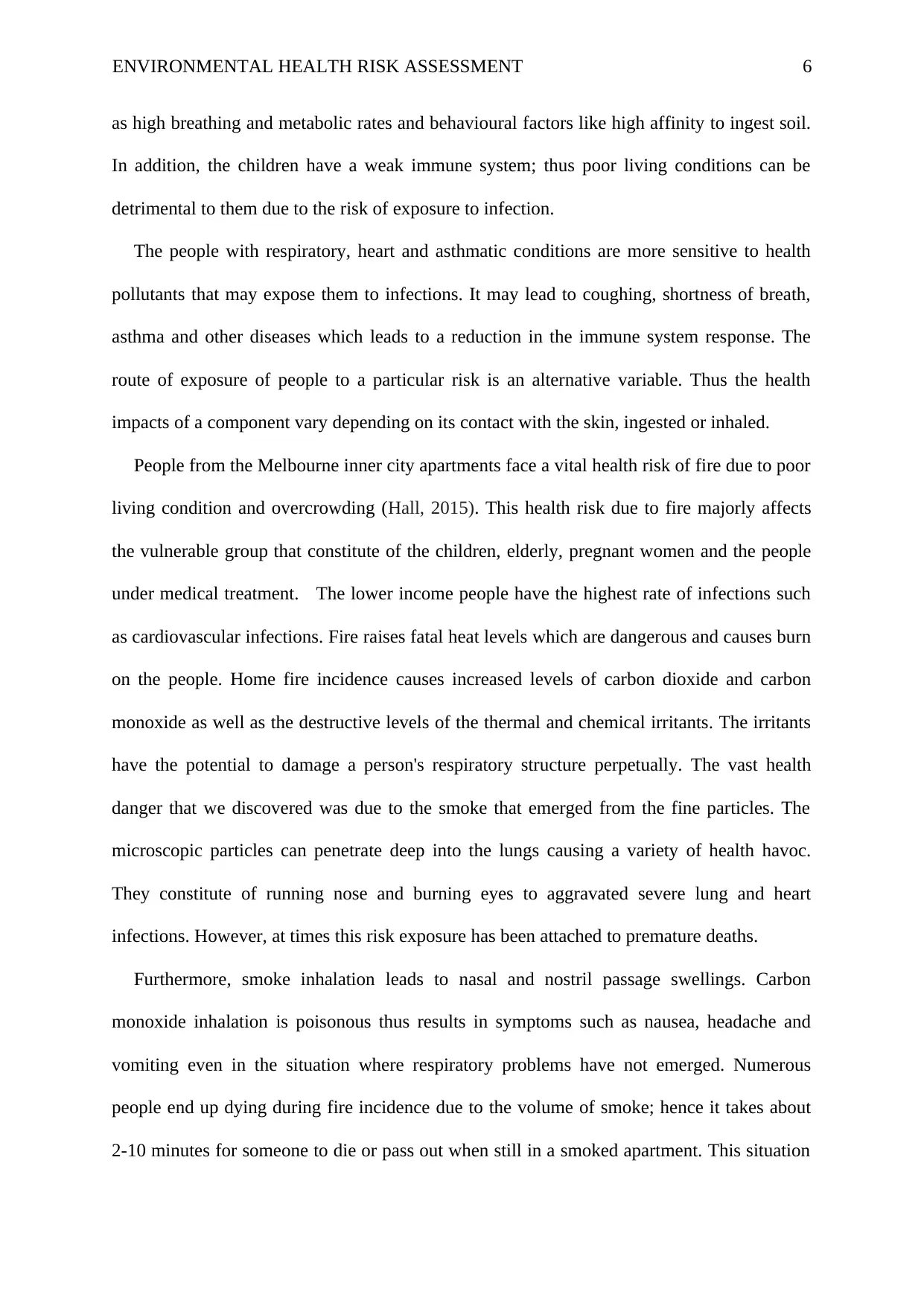
ENVIRONMENTAL HEALTH RISK ASSESSMENT 6
as high breathing and metabolic rates and behavioural factors like high affinity to ingest soil.
In addition, the children have a weak immune system; thus poor living conditions can be
detrimental to them due to the risk of exposure to infection.
The people with respiratory, heart and asthmatic conditions are more sensitive to health
pollutants that may expose them to infections. It may lead to coughing, shortness of breath,
asthma and other diseases which leads to a reduction in the immune system response. The
route of exposure of people to a particular risk is an alternative variable. Thus the health
impacts of a component vary depending on its contact with the skin, ingested or inhaled.
People from the Melbourne inner city apartments face a vital health risk of fire due to poor
living condition and overcrowding (Hall, 2015). This health risk due to fire majorly affects
the vulnerable group that constitute of the children, elderly, pregnant women and the people
under medical treatment. The lower income people have the highest rate of infections such
as cardiovascular infections. Fire raises fatal heat levels which are dangerous and causes burn
on the people. Home fire incidence causes increased levels of carbon dioxide and carbon
monoxide as well as the destructive levels of the thermal and chemical irritants. The irritants
have the potential to damage a person's respiratory structure perpetually. The vast health
danger that we discovered was due to the smoke that emerged from the fine particles. The
microscopic particles can penetrate deep into the lungs causing a variety of health havoc.
They constitute of running nose and burning eyes to aggravated severe lung and heart
infections. However, at times this risk exposure has been attached to premature deaths.
Furthermore, smoke inhalation leads to nasal and nostril passage swellings. Carbon
monoxide inhalation is poisonous thus results in symptoms such as nausea, headache and
vomiting even in the situation where respiratory problems have not emerged. Numerous
people end up dying during fire incidence due to the volume of smoke; hence it takes about
2-10 minutes for someone to die or pass out when still in a smoked apartment. This situation
as high breathing and metabolic rates and behavioural factors like high affinity to ingest soil.
In addition, the children have a weak immune system; thus poor living conditions can be
detrimental to them due to the risk of exposure to infection.
The people with respiratory, heart and asthmatic conditions are more sensitive to health
pollutants that may expose them to infections. It may lead to coughing, shortness of breath,
asthma and other diseases which leads to a reduction in the immune system response. The
route of exposure of people to a particular risk is an alternative variable. Thus the health
impacts of a component vary depending on its contact with the skin, ingested or inhaled.
People from the Melbourne inner city apartments face a vital health risk of fire due to poor
living condition and overcrowding (Hall, 2015). This health risk due to fire majorly affects
the vulnerable group that constitute of the children, elderly, pregnant women and the people
under medical treatment. The lower income people have the highest rate of infections such
as cardiovascular infections. Fire raises fatal heat levels which are dangerous and causes burn
on the people. Home fire incidence causes increased levels of carbon dioxide and carbon
monoxide as well as the destructive levels of the thermal and chemical irritants. The irritants
have the potential to damage a person's respiratory structure perpetually. The vast health
danger that we discovered was due to the smoke that emerged from the fine particles. The
microscopic particles can penetrate deep into the lungs causing a variety of health havoc.
They constitute of running nose and burning eyes to aggravated severe lung and heart
infections. However, at times this risk exposure has been attached to premature deaths.
Furthermore, smoke inhalation leads to nasal and nostril passage swellings. Carbon
monoxide inhalation is poisonous thus results in symptoms such as nausea, headache and
vomiting even in the situation where respiratory problems have not emerged. Numerous
people end up dying during fire incidence due to the volume of smoke; hence it takes about
2-10 minutes for someone to die or pass out when still in a smoked apartment. This situation
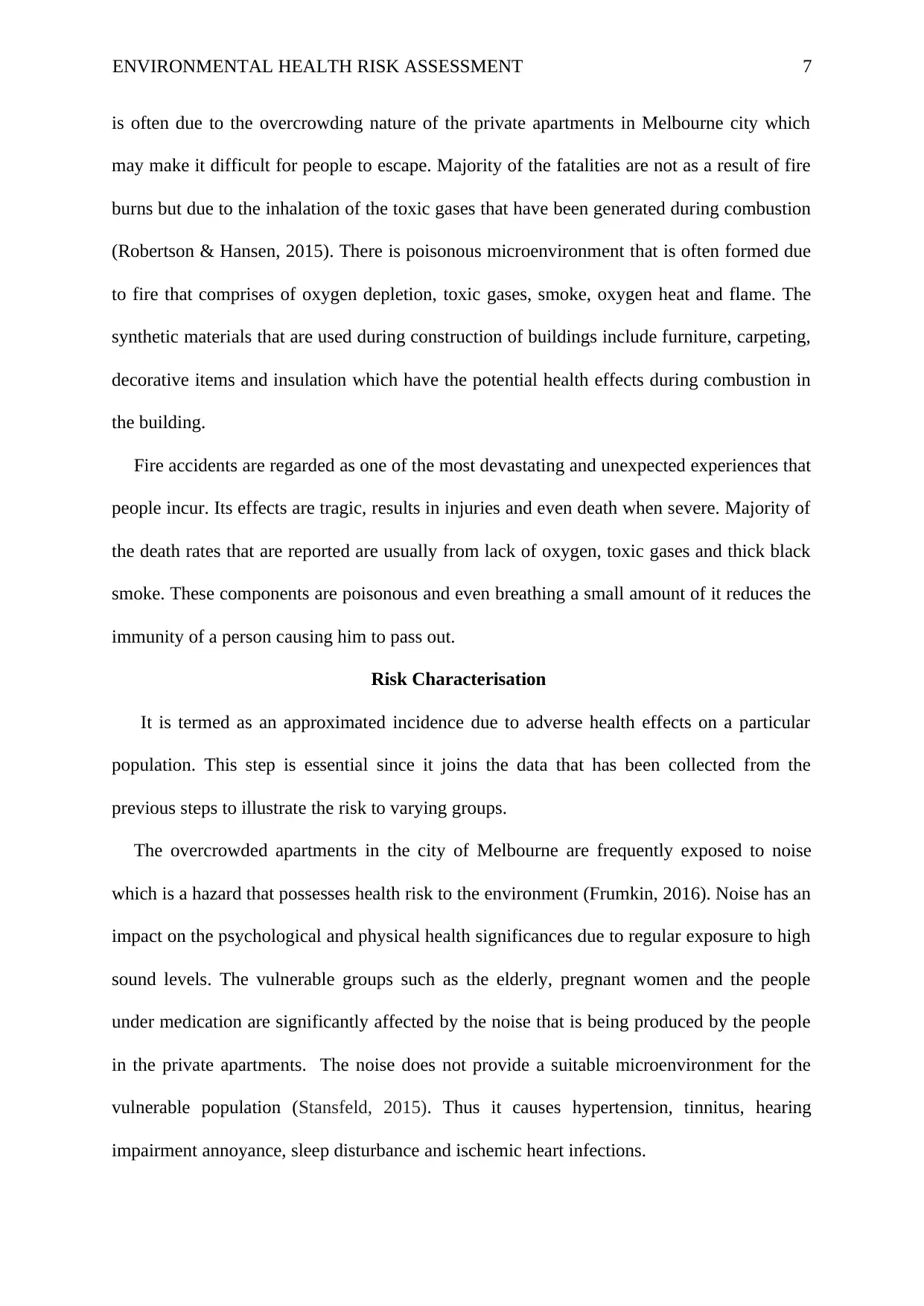
ENVIRONMENTAL HEALTH RISK ASSESSMENT 7
is often due to the overcrowding nature of the private apartments in Melbourne city which
may make it difficult for people to escape. Majority of the fatalities are not as a result of fire
burns but due to the inhalation of the toxic gases that have been generated during combustion
(Robertson & Hansen, 2015). There is poisonous microenvironment that is often formed due
to fire that comprises of oxygen depletion, toxic gases, smoke, oxygen heat and flame. The
synthetic materials that are used during construction of buildings include furniture, carpeting,
decorative items and insulation which have the potential health effects during combustion in
the building.
Fire accidents are regarded as one of the most devastating and unexpected experiences that
people incur. Its effects are tragic, results in injuries and even death when severe. Majority of
the death rates that are reported are usually from lack of oxygen, toxic gases and thick black
smoke. These components are poisonous and even breathing a small amount of it reduces the
immunity of a person causing him to pass out.
Risk Characterisation
It is termed as an approximated incidence due to adverse health effects on a particular
population. This step is essential since it joins the data that has been collected from the
previous steps to illustrate the risk to varying groups.
The overcrowded apartments in the city of Melbourne are frequently exposed to noise
which is a hazard that possesses health risk to the environment (Frumkin, 2016). Noise has an
impact on the psychological and physical health significances due to regular exposure to high
sound levels. The vulnerable groups such as the elderly, pregnant women and the people
under medication are significantly affected by the noise that is being produced by the people
in the private apartments. The noise does not provide a suitable microenvironment for the
vulnerable population (Stansfeld, 2015). Thus it causes hypertension, tinnitus, hearing
impairment annoyance, sleep disturbance and ischemic heart infections.
is often due to the overcrowding nature of the private apartments in Melbourne city which
may make it difficult for people to escape. Majority of the fatalities are not as a result of fire
burns but due to the inhalation of the toxic gases that have been generated during combustion
(Robertson & Hansen, 2015). There is poisonous microenvironment that is often formed due
to fire that comprises of oxygen depletion, toxic gases, smoke, oxygen heat and flame. The
synthetic materials that are used during construction of buildings include furniture, carpeting,
decorative items and insulation which have the potential health effects during combustion in
the building.
Fire accidents are regarded as one of the most devastating and unexpected experiences that
people incur. Its effects are tragic, results in injuries and even death when severe. Majority of
the death rates that are reported are usually from lack of oxygen, toxic gases and thick black
smoke. These components are poisonous and even breathing a small amount of it reduces the
immunity of a person causing him to pass out.
Risk Characterisation
It is termed as an approximated incidence due to adverse health effects on a particular
population. This step is essential since it joins the data that has been collected from the
previous steps to illustrate the risk to varying groups.
The overcrowded apartments in the city of Melbourne are frequently exposed to noise
which is a hazard that possesses health risk to the environment (Frumkin, 2016). Noise has an
impact on the psychological and physical health significances due to regular exposure to high
sound levels. The vulnerable groups such as the elderly, pregnant women and the people
under medication are significantly affected by the noise that is being produced by the people
in the private apartments. The noise does not provide a suitable microenvironment for the
vulnerable population (Stansfeld, 2015). Thus it causes hypertension, tinnitus, hearing
impairment annoyance, sleep disturbance and ischemic heart infections.
Paraphrase This Document
Need a fresh take? Get an instant paraphrase of this document with our AI Paraphraser
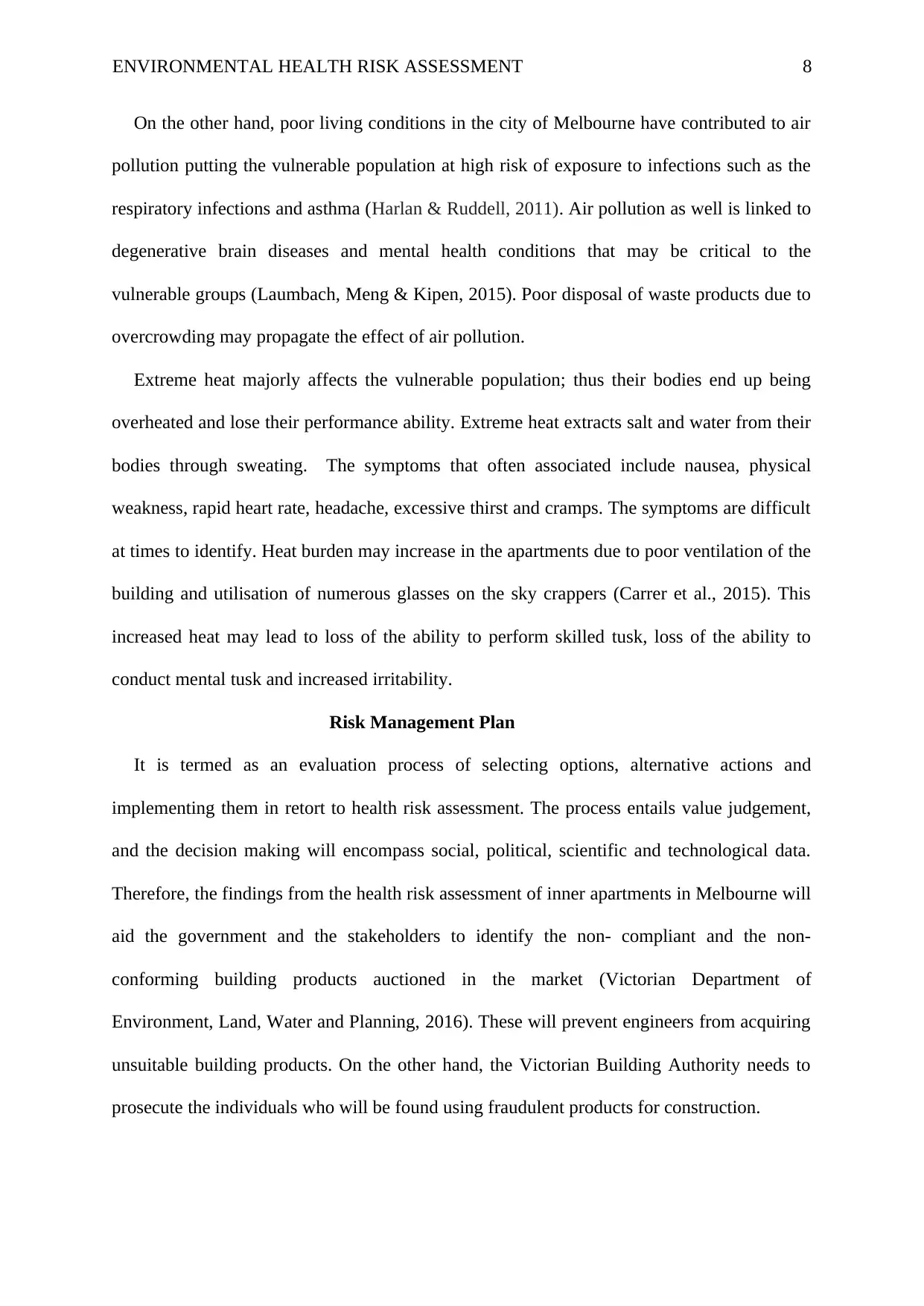
ENVIRONMENTAL HEALTH RISK ASSESSMENT 8
On the other hand, poor living conditions in the city of Melbourne have contributed to air
pollution putting the vulnerable population at high risk of exposure to infections such as the
respiratory infections and asthma (Harlan & Ruddell, 2011). Air pollution as well is linked to
degenerative brain diseases and mental health conditions that may be critical to the
vulnerable groups (Laumbach, Meng & Kipen, 2015). Poor disposal of waste products due to
overcrowding may propagate the effect of air pollution.
Extreme heat majorly affects the vulnerable population; thus their bodies end up being
overheated and lose their performance ability. Extreme heat extracts salt and water from their
bodies through sweating. The symptoms that often associated include nausea, physical
weakness, rapid heart rate, headache, excessive thirst and cramps. The symptoms are difficult
at times to identify. Heat burden may increase in the apartments due to poor ventilation of the
building and utilisation of numerous glasses on the sky crappers (Carrer et al., 2015). This
increased heat may lead to loss of the ability to perform skilled tusk, loss of the ability to
conduct mental tusk and increased irritability.
Risk Management Plan
It is termed as an evaluation process of selecting options, alternative actions and
implementing them in retort to health risk assessment. The process entails value judgement,
and the decision making will encompass social, political, scientific and technological data.
Therefore, the findings from the health risk assessment of inner apartments in Melbourne will
aid the government and the stakeholders to identify the non- compliant and the non-
conforming building products auctioned in the market (Victorian Department of
Environment, Land, Water and Planning, 2016). These will prevent engineers from acquiring
unsuitable building products. On the other hand, the Victorian Building Authority needs to
prosecute the individuals who will be found using fraudulent products for construction.
On the other hand, poor living conditions in the city of Melbourne have contributed to air
pollution putting the vulnerable population at high risk of exposure to infections such as the
respiratory infections and asthma (Harlan & Ruddell, 2011). Air pollution as well is linked to
degenerative brain diseases and mental health conditions that may be critical to the
vulnerable groups (Laumbach, Meng & Kipen, 2015). Poor disposal of waste products due to
overcrowding may propagate the effect of air pollution.
Extreme heat majorly affects the vulnerable population; thus their bodies end up being
overheated and lose their performance ability. Extreme heat extracts salt and water from their
bodies through sweating. The symptoms that often associated include nausea, physical
weakness, rapid heart rate, headache, excessive thirst and cramps. The symptoms are difficult
at times to identify. Heat burden may increase in the apartments due to poor ventilation of the
building and utilisation of numerous glasses on the sky crappers (Carrer et al., 2015). This
increased heat may lead to loss of the ability to perform skilled tusk, loss of the ability to
conduct mental tusk and increased irritability.
Risk Management Plan
It is termed as an evaluation process of selecting options, alternative actions and
implementing them in retort to health risk assessment. The process entails value judgement,
and the decision making will encompass social, political, scientific and technological data.
Therefore, the findings from the health risk assessment of inner apartments in Melbourne will
aid the government and the stakeholders to identify the non- compliant and the non-
conforming building products auctioned in the market (Victorian Department of
Environment, Land, Water and Planning, 2016). These will prevent engineers from acquiring
unsuitable building products. On the other hand, the Victorian Building Authority needs to
prosecute the individuals who will be found using fraudulent products for construction.
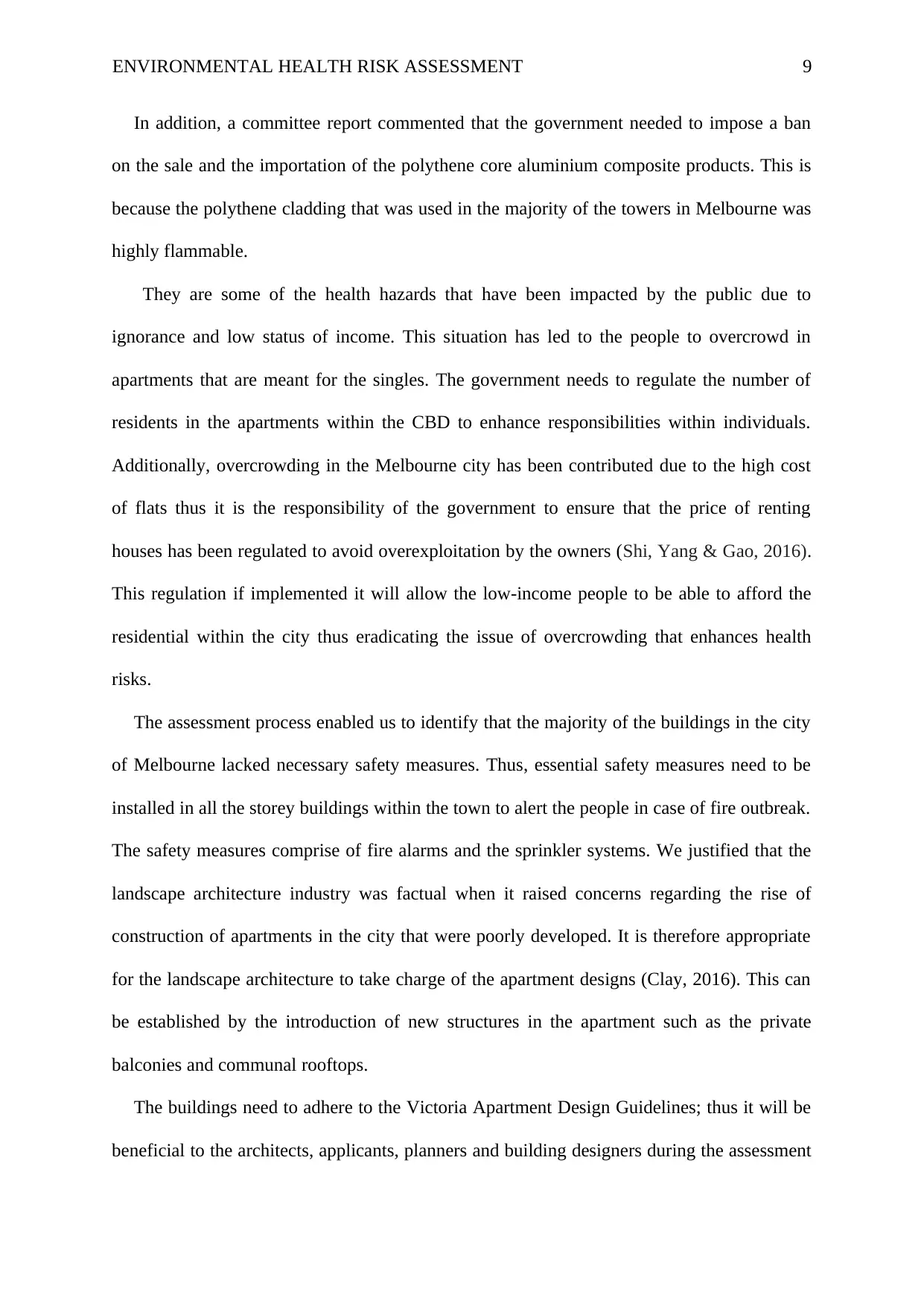
ENVIRONMENTAL HEALTH RISK ASSESSMENT 9
In addition, a committee report commented that the government needed to impose a ban
on the sale and the importation of the polythene core aluminium composite products. This is
because the polythene cladding that was used in the majority of the towers in Melbourne was
highly flammable.
They are some of the health hazards that have been impacted by the public due to
ignorance and low status of income. This situation has led to the people to overcrowd in
apartments that are meant for the singles. The government needs to regulate the number of
residents in the apartments within the CBD to enhance responsibilities within individuals.
Additionally, overcrowding in the Melbourne city has been contributed due to the high cost
of flats thus it is the responsibility of the government to ensure that the price of renting
houses has been regulated to avoid overexploitation by the owners (Shi, Yang & Gao, 2016).
This regulation if implemented it will allow the low-income people to be able to afford the
residential within the city thus eradicating the issue of overcrowding that enhances health
risks.
The assessment process enabled us to identify that the majority of the buildings in the city
of Melbourne lacked necessary safety measures. Thus, essential safety measures need to be
installed in all the storey buildings within the town to alert the people in case of fire outbreak.
The safety measures comprise of fire alarms and the sprinkler systems. We justified that the
landscape architecture industry was factual when it raised concerns regarding the rise of
construction of apartments in the city that were poorly developed. It is therefore appropriate
for the landscape architecture to take charge of the apartment designs (Clay, 2016). This can
be established by the introduction of new structures in the apartment such as the private
balconies and communal rooftops.
The buildings need to adhere to the Victoria Apartment Design Guidelines; thus it will be
beneficial to the architects, applicants, planners and building designers during the assessment
In addition, a committee report commented that the government needed to impose a ban
on the sale and the importation of the polythene core aluminium composite products. This is
because the polythene cladding that was used in the majority of the towers in Melbourne was
highly flammable.
They are some of the health hazards that have been impacted by the public due to
ignorance and low status of income. This situation has led to the people to overcrowd in
apartments that are meant for the singles. The government needs to regulate the number of
residents in the apartments within the CBD to enhance responsibilities within individuals.
Additionally, overcrowding in the Melbourne city has been contributed due to the high cost
of flats thus it is the responsibility of the government to ensure that the price of renting
houses has been regulated to avoid overexploitation by the owners (Shi, Yang & Gao, 2016).
This regulation if implemented it will allow the low-income people to be able to afford the
residential within the city thus eradicating the issue of overcrowding that enhances health
risks.
The assessment process enabled us to identify that the majority of the buildings in the city
of Melbourne lacked necessary safety measures. Thus, essential safety measures need to be
installed in all the storey buildings within the town to alert the people in case of fire outbreak.
The safety measures comprise of fire alarms and the sprinkler systems. We justified that the
landscape architecture industry was factual when it raised concerns regarding the rise of
construction of apartments in the city that were poorly developed. It is therefore appropriate
for the landscape architecture to take charge of the apartment designs (Clay, 2016). This can
be established by the introduction of new structures in the apartment such as the private
balconies and communal rooftops.
The buildings need to adhere to the Victoria Apartment Design Guidelines; thus it will be
beneficial to the architects, applicants, planners and building designers during the assessment
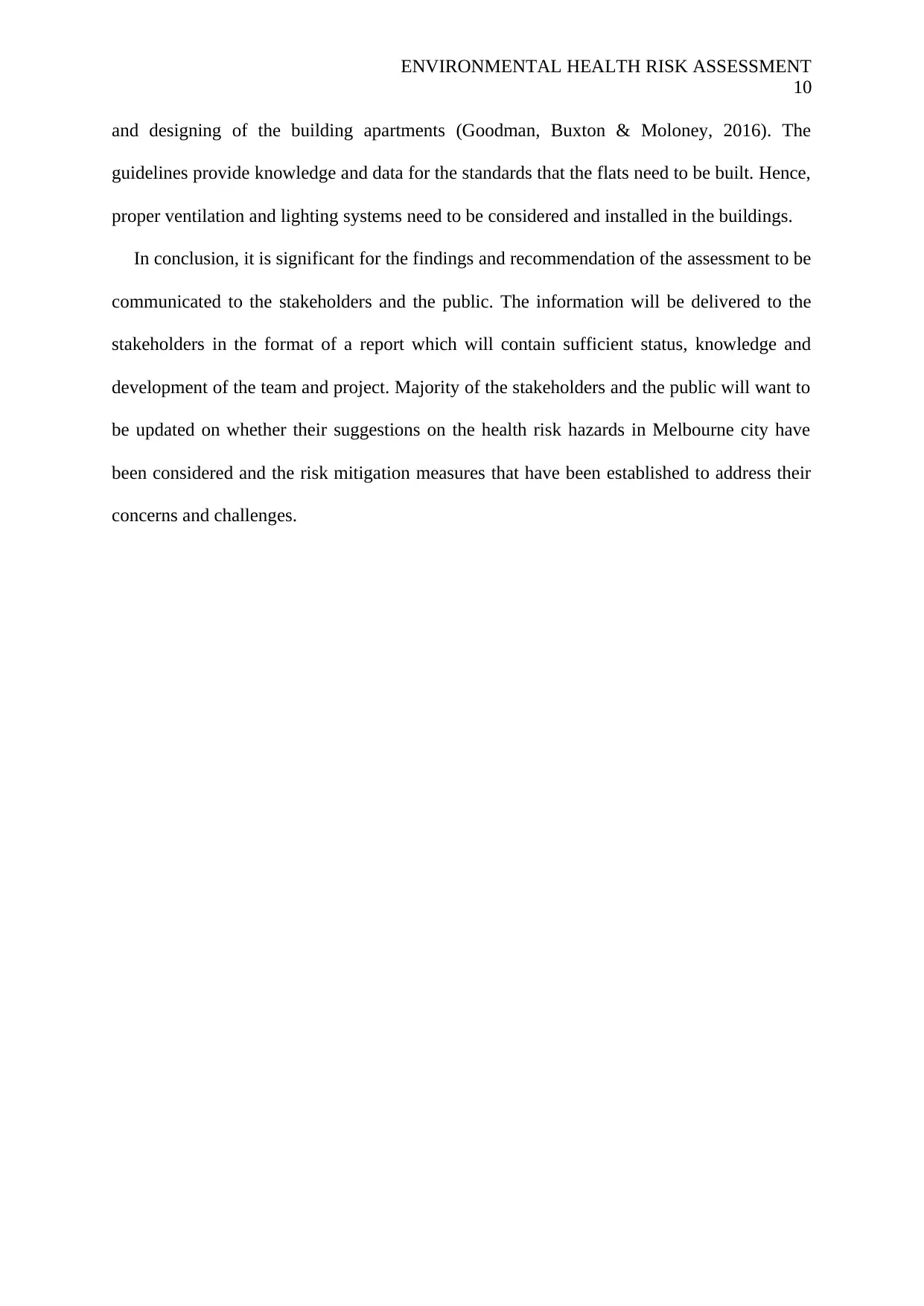
ENVIRONMENTAL HEALTH RISK ASSESSMENT
10
and designing of the building apartments (Goodman, Buxton & Moloney, 2016). The
guidelines provide knowledge and data for the standards that the flats need to be built. Hence,
proper ventilation and lighting systems need to be considered and installed in the buildings.
In conclusion, it is significant for the findings and recommendation of the assessment to be
communicated to the stakeholders and the public. The information will be delivered to the
stakeholders in the format of a report which will contain sufficient status, knowledge and
development of the team and project. Majority of the stakeholders and the public will want to
be updated on whether their suggestions on the health risk hazards in Melbourne city have
been considered and the risk mitigation measures that have been established to address their
concerns and challenges.
10
and designing of the building apartments (Goodman, Buxton & Moloney, 2016). The
guidelines provide knowledge and data for the standards that the flats need to be built. Hence,
proper ventilation and lighting systems need to be considered and installed in the buildings.
In conclusion, it is significant for the findings and recommendation of the assessment to be
communicated to the stakeholders and the public. The information will be delivered to the
stakeholders in the format of a report which will contain sufficient status, knowledge and
development of the team and project. Majority of the stakeholders and the public will want to
be updated on whether their suggestions on the health risk hazards in Melbourne city have
been considered and the risk mitigation measures that have been established to address their
concerns and challenges.
Secure Best Marks with AI Grader
Need help grading? Try our AI Grader for instant feedback on your assignments.
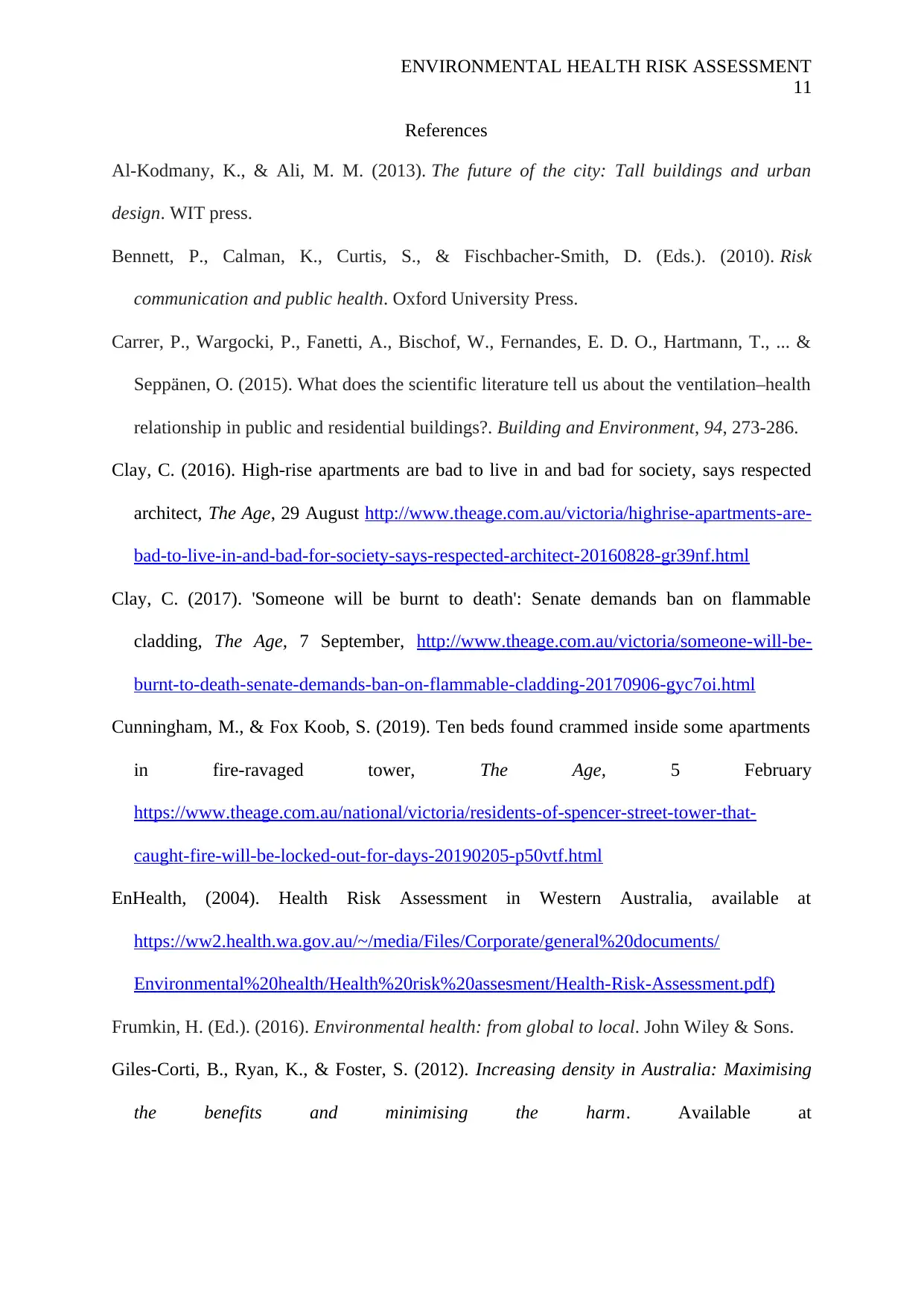
ENVIRONMENTAL HEALTH RISK ASSESSMENT
11
References
Al-Kodmany, K., & Ali, M. M. (2013). The future of the city: Tall buildings and urban
design. WIT press.
Bennett, P., Calman, K., Curtis, S., & Fischbacher-Smith, D. (Eds.). (2010). Risk
communication and public health. Oxford University Press.
Carrer, P., Wargocki, P., Fanetti, A., Bischof, W., Fernandes, E. D. O., Hartmann, T., ... &
Seppänen, O. (2015). What does the scientific literature tell us about the ventilation–health
relationship in public and residential buildings?. Building and Environment, 94, 273-286.
Clay, C. (2016). High-rise apartments are bad to live in and bad for society, says respected
architect, The Age, 29 August http://www.theage.com.au/victoria/highrise-apartments-are-
bad-to-live-in-and-bad-for-society-says-respected-architect-20160828-gr39nf.html
Clay, C. (2017). 'Someone will be burnt to death': Senate demands ban on flammable
cladding, The Age, 7 September, http://www.theage.com.au/victoria/someone-will-be-
burnt-to-death-senate-demands-ban-on-flammable-cladding-20170906-gyc7oi.html
Cunningham, M., & Fox Koob, S. (2019). Ten beds found crammed inside some apartments
in fire-ravaged tower, The Age, 5 February
https://www.theage.com.au/national/victoria/residents-of-spencer-street-tower-that-
caught-fire-will-be-locked-out-for-days-20190205-p50vtf.html
EnHealth, (2004). Health Risk Assessment in Western Australia, available at
https://ww2.health.wa.gov.au/~/media/Files/Corporate/general%20documents/
Environmental%20health/Health%20risk%20assesment/Health-Risk-Assessment.pdf)
Frumkin, H. (Ed.). (2016). Environmental health: from global to local. John Wiley & Sons.
Giles-Corti, B., Ryan, K., & Foster, S. (2012). Increasing density in Australia: Maximising
the benefits and minimising the harm. Available at
11
References
Al-Kodmany, K., & Ali, M. M. (2013). The future of the city: Tall buildings and urban
design. WIT press.
Bennett, P., Calman, K., Curtis, S., & Fischbacher-Smith, D. (Eds.). (2010). Risk
communication and public health. Oxford University Press.
Carrer, P., Wargocki, P., Fanetti, A., Bischof, W., Fernandes, E. D. O., Hartmann, T., ... &
Seppänen, O. (2015). What does the scientific literature tell us about the ventilation–health
relationship in public and residential buildings?. Building and Environment, 94, 273-286.
Clay, C. (2016). High-rise apartments are bad to live in and bad for society, says respected
architect, The Age, 29 August http://www.theage.com.au/victoria/highrise-apartments-are-
bad-to-live-in-and-bad-for-society-says-respected-architect-20160828-gr39nf.html
Clay, C. (2017). 'Someone will be burnt to death': Senate demands ban on flammable
cladding, The Age, 7 September, http://www.theage.com.au/victoria/someone-will-be-
burnt-to-death-senate-demands-ban-on-flammable-cladding-20170906-gyc7oi.html
Cunningham, M., & Fox Koob, S. (2019). Ten beds found crammed inside some apartments
in fire-ravaged tower, The Age, 5 February
https://www.theage.com.au/national/victoria/residents-of-spencer-street-tower-that-
caught-fire-will-be-locked-out-for-days-20190205-p50vtf.html
EnHealth, (2004). Health Risk Assessment in Western Australia, available at
https://ww2.health.wa.gov.au/~/media/Files/Corporate/general%20documents/
Environmental%20health/Health%20risk%20assesment/Health-Risk-Assessment.pdf)
Frumkin, H. (Ed.). (2016). Environmental health: from global to local. John Wiley & Sons.
Giles-Corti, B., Ryan, K., & Foster, S. (2012). Increasing density in Australia: Maximising
the benefits and minimising the harm. Available at
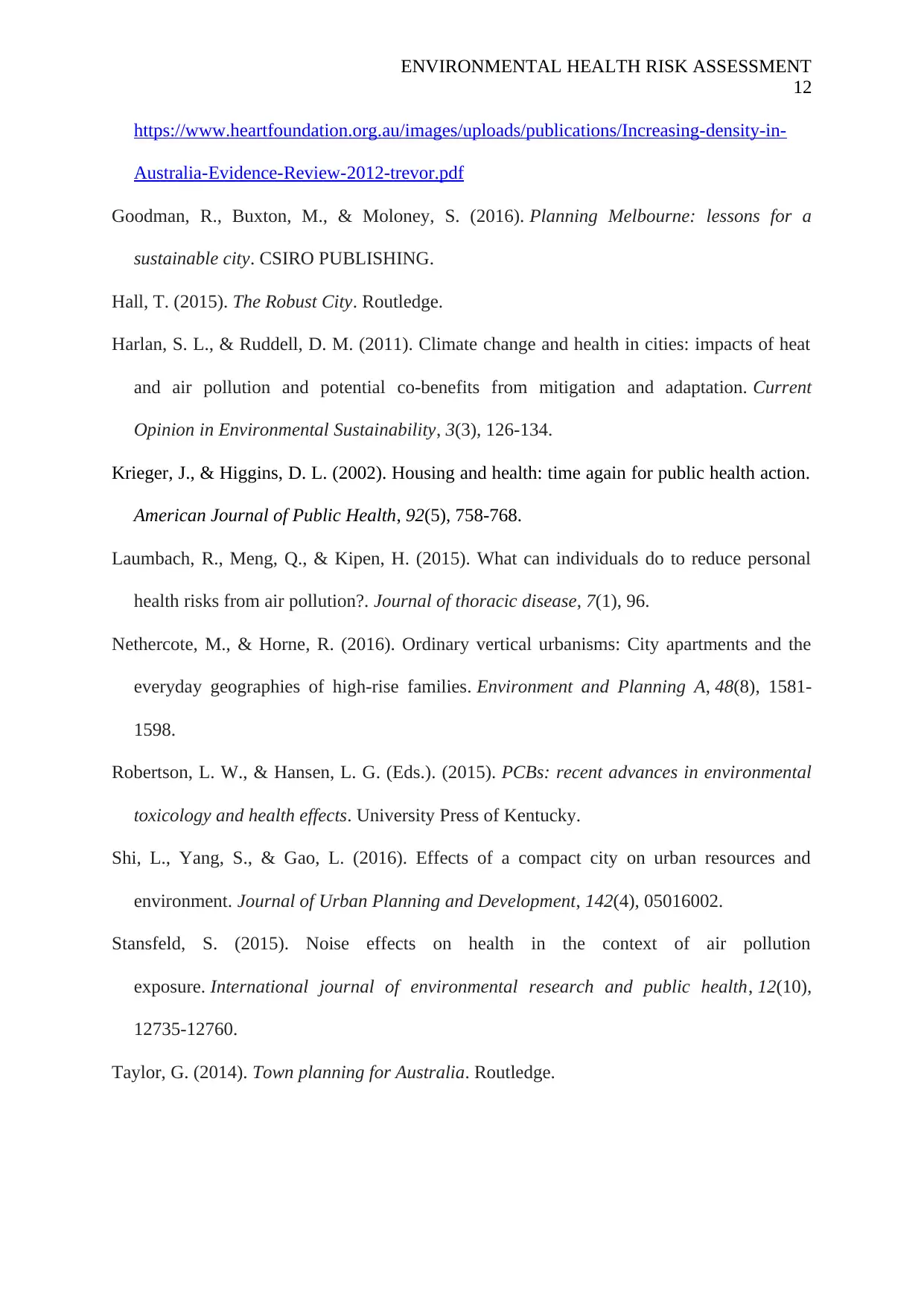
ENVIRONMENTAL HEALTH RISK ASSESSMENT
12
https://www.heartfoundation.org.au/images/uploads/publications/Increasing-density-in-
Australia-Evidence-Review-2012-trevor.pdf
Goodman, R., Buxton, M., & Moloney, S. (2016). Planning Melbourne: lessons for a
sustainable city. CSIRO PUBLISHING.
Hall, T. (2015). The Robust City. Routledge.
Harlan, S. L., & Ruddell, D. M. (2011). Climate change and health in cities: impacts of heat
and air pollution and potential co-benefits from mitigation and adaptation. Current
Opinion in Environmental Sustainability, 3(3), 126-134.
Krieger, J., & Higgins, D. L. (2002). Housing and health: time again for public health action.
American Journal of Public Health, 92(5), 758-768.
Laumbach, R., Meng, Q., & Kipen, H. (2015). What can individuals do to reduce personal
health risks from air pollution?. Journal of thoracic disease, 7(1), 96.
Nethercote, M., & Horne, R. (2016). Ordinary vertical urbanisms: City apartments and the
everyday geographies of high-rise families. Environment and Planning A, 48(8), 1581-
1598.
Robertson, L. W., & Hansen, L. G. (Eds.). (2015). PCBs: recent advances in environmental
toxicology and health effects. University Press of Kentucky.
Shi, L., Yang, S., & Gao, L. (2016). Effects of a compact city on urban resources and
environment. Journal of Urban Planning and Development, 142(4), 05016002.
Stansfeld, S. (2015). Noise effects on health in the context of air pollution
exposure. International journal of environmental research and public health, 12(10),
12735-12760.
Taylor, G. (2014). Town planning for Australia. Routledge.
12
https://www.heartfoundation.org.au/images/uploads/publications/Increasing-density-in-
Australia-Evidence-Review-2012-trevor.pdf
Goodman, R., Buxton, M., & Moloney, S. (2016). Planning Melbourne: lessons for a
sustainable city. CSIRO PUBLISHING.
Hall, T. (2015). The Robust City. Routledge.
Harlan, S. L., & Ruddell, D. M. (2011). Climate change and health in cities: impacts of heat
and air pollution and potential co-benefits from mitigation and adaptation. Current
Opinion in Environmental Sustainability, 3(3), 126-134.
Krieger, J., & Higgins, D. L. (2002). Housing and health: time again for public health action.
American Journal of Public Health, 92(5), 758-768.
Laumbach, R., Meng, Q., & Kipen, H. (2015). What can individuals do to reduce personal
health risks from air pollution?. Journal of thoracic disease, 7(1), 96.
Nethercote, M., & Horne, R. (2016). Ordinary vertical urbanisms: City apartments and the
everyday geographies of high-rise families. Environment and Planning A, 48(8), 1581-
1598.
Robertson, L. W., & Hansen, L. G. (Eds.). (2015). PCBs: recent advances in environmental
toxicology and health effects. University Press of Kentucky.
Shi, L., Yang, S., & Gao, L. (2016). Effects of a compact city on urban resources and
environment. Journal of Urban Planning and Development, 142(4), 05016002.
Stansfeld, S. (2015). Noise effects on health in the context of air pollution
exposure. International journal of environmental research and public health, 12(10),
12735-12760.
Taylor, G. (2014). Town planning for Australia. Routledge.
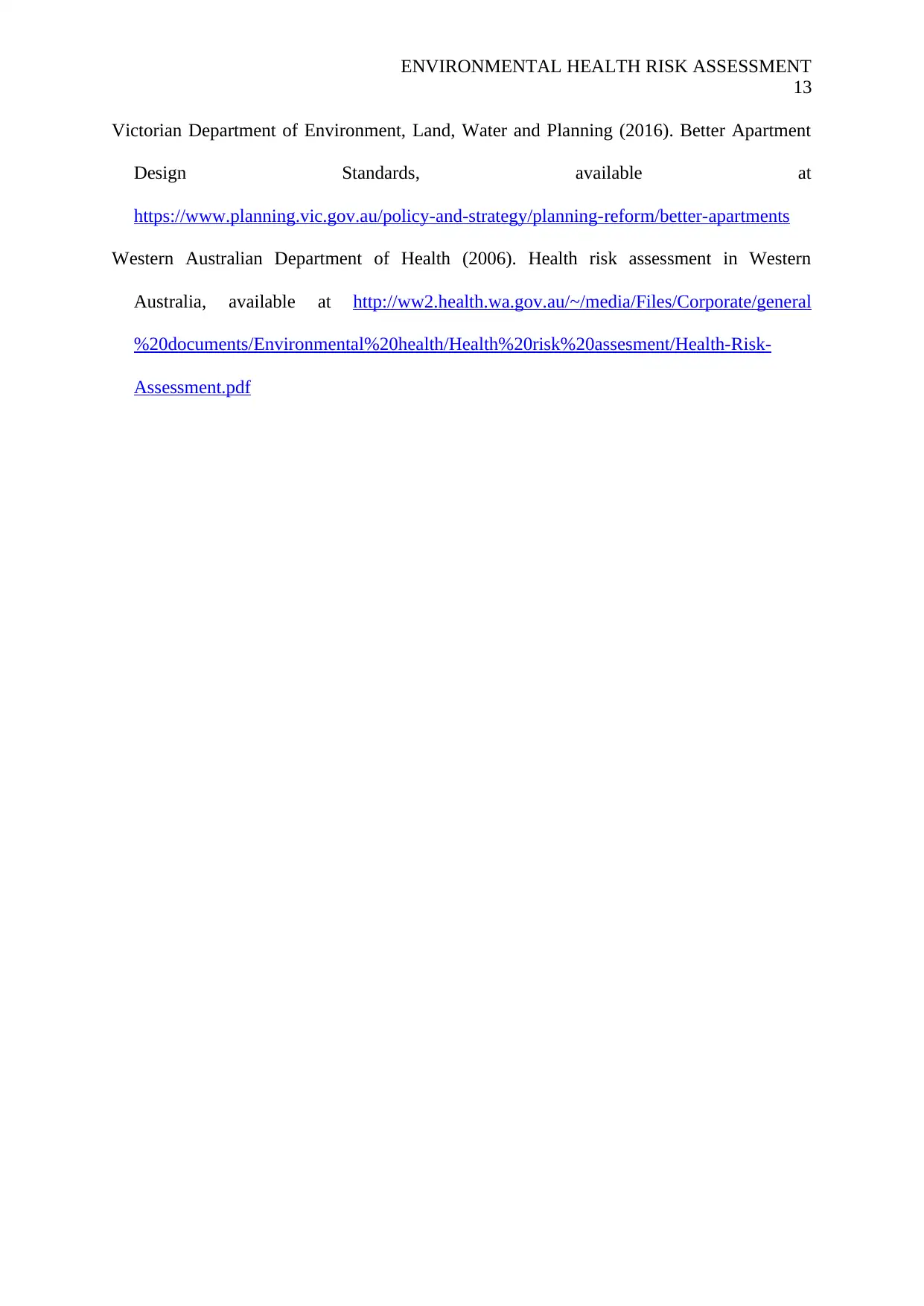
ENVIRONMENTAL HEALTH RISK ASSESSMENT
13
Victorian Department of Environment, Land, Water and Planning (2016). Better Apartment
Design Standards, available at
https://www.planning.vic.gov.au/policy-and-strategy/planning-reform/better-apartments
Western Australian Department of Health (2006). Health risk assessment in Western
Australia, available at http://ww2.health.wa.gov.au/~/media/Files/Corporate/general
%20documents/Environmental%20health/Health%20risk%20assesment/Health-Risk-
Assessment.pdf
13
Victorian Department of Environment, Land, Water and Planning (2016). Better Apartment
Design Standards, available at
https://www.planning.vic.gov.au/policy-and-strategy/planning-reform/better-apartments
Western Australian Department of Health (2006). Health risk assessment in Western
Australia, available at http://ww2.health.wa.gov.au/~/media/Files/Corporate/general
%20documents/Environmental%20health/Health%20risk%20assesment/Health-Risk-
Assessment.pdf
1 out of 13
Related Documents
Your All-in-One AI-Powered Toolkit for Academic Success.
+13062052269
info@desklib.com
Available 24*7 on WhatsApp / Email
![[object Object]](/_next/static/media/star-bottom.7253800d.svg)
Unlock your academic potential
© 2024 | Zucol Services PVT LTD | All rights reserved.





